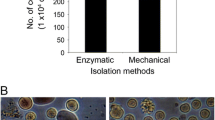Abstract
Regarding challenges in isolation and maintenance of cultured heart cells, introduction of new in vitro heart model that is stable and exhibits long-term spontaneously contracting cell aggregates (SCCs), whose electrophysiological properties are comparable to the human heart, is required. This research aimed to establish cardiac primary cells and to evaluate the effects of culture conditions. Also the effect of fish age on beating SCC and cardiac cell morphology were studied. Twelve healthy grass carps (Ctenopharyngodon idella) were divided into four groups based on their age. Non-enzymatic explant culture was used and heart explants were incubated at 21–31 °C for 60 days. After proliferation of the cardiac primary cells, changes in their morphology and their beatings were recorded. The results showed that the explants derived from different age of grass carp fish are fully viable and proliferative with formation of SCC for a long period of time. By increasing the number of adhered cells, the cardiac primary cells became more flat and elongated. Increasing the medium temperature and fetal bovine serum concentration in culture medium led to decline and enhancement in beat frequencies of heart cell aggregates, respectively. Also, grass carp heart explant had high potential in regeneration (especially in young fish) and thus high feasibility to generate stable long-term cultures. In general, it seems that explant culture of heart from grass carp can be considered as a promising tool in heart research area.



Similar content being viewed by others
References
Brette F, Luxan G, Cros C, Dixey H, Wilson C, Shiels HA (2008) Characterization of isolated ventricular myocytes from adult zebrafish (Danio rerio). Biochem Biophys Res Commun 374:143–146
Carmeliet E (2004) Intracellular Ca2+ concentration and rate adaptation of the cardiac action potential. Cell Calcium 35:557–573
Cudmore B, Mandrak NE (2004) Biological synopsis of grass carp (Ctenopharyngodon idella). Canadian manuscript report of Fisheries and Aquatic Sciences, 2705
Gesser H (1996) Cardiac force-interval relationship, adrenaline and sarcoplasmic reticulum in rainbow trout. J Comp Physiol B 166:278–285
Grunow B, Ciba P, Rakers S, Klinger M, Anders E, Kruse C (2010) In vitro expansion of autonomously contracting, cardiomyogenic structures from rainbow trout Oncorhynchus mykiss. J Fish Biol 76:427–434
Grunow B, Wenzel J, Terlau H, Langner S, Gebert M, Kruse C (2011) In vitro developed spontaneously contracting cardiomyocytes from rainbow trout as a model system for human heart research. Cell Physiol Biochem 27:1–12
Gut P, Reischauer S, Stainier DY, Arnaout R (2017) Little fish, big data: zebrafish as a model for cardiovascular and metabolic disease. Physiol Rev 97:889–938
Hodgson P, Ireland J, Grunow B (2018) Fish, the better model in human heart research? Zebrafish heart aggregates as a 3D spontaneously cardiomyogenic in vitro model system. Prog Biophys Mol Biol. https://doi.org/10.1016/j.pbiomolbio.2018.04.009
Horrobin DF (2003) Modern biomedical research: an internally self-consistent universe with little contact with medical reality? Nat Rev Drug Discov 2:151
Kikuchi K et al (2010) Primary contribution to zebrafish heart regeneration by gata4 + cardiomyocytes. Nature 464:601
Matrone G, Tucker CS, Denvir MA (2017) Cardiomyocyte proliferation in zebrafish and mammals: lessons for human disease. Cell Mol Life Sci 74:1367–1378
Milan DJ, Jones IL, Ellinor PT, MacRae CA (2006) In vivo recording of adult zebrafish electrocardiogram and assessment of drug-induced QT prolongation. Am J Physiol Heart Circ Physiol 291:H269–H273
Nemtsas P, Wettwer E, Christ T, Weidinger G, Ravens U (2010) Adult zebrafish heart as a model for human heart? An electrophysiological study. J Mol Cell Cardiol 48:161–171
Noguera PA, Grunow B, Klinger M, Lester K, Collet B, del-Pozo J (2017) Atlantic salmon cardiac primary cultures: an in vitro model to study viral host pathogen interactions and pathogenesis. PLoS ONE 12:e0181058
Parameswaran S, Kumar S, Verma RS, Sharma RK (2013) Cardiomyocyte culture—an update on the in vitro cardiovascular model and future challenges. Can J Physiol Pharmacol 91:985–998
Phillips JB, Westerfield M (2014) Zebrafish models in translational research: tipping the scales toward advancements in human health. Dis Models Mech 7:739–743
Pieperhoff S et al (2014) Heart on a plate: histological and functional assessment of isolated adult zebrafish hearts maintained in culture. PLoS ONE 9:e96771
Remião F, Carmo H, Carvalho F, Bastos M (2001) The study of oxidative stress in freshly isolated Ca2+-tolerant cardiomyocytes from the adult rat. Toxicol In Vitro 15:283–287
Sander V, Suñe G, Jopling C, Morera C, Belmonte JCI (2013) Isolation and in vitro culture of primary cardiomyocytes from adult zebrafish hearts. Nat Protoc 8:800
Shiels HA, Vornanen M, Farrell AP (2002) Effects of temperature on intracellular [Ca2+] in trout atrial myocytes. J Exp Biol 205:3641–3650
Shiels HA, Calaghan SC, White E (2006) The cellular basis for enhanced volume-modulated cardiac output in fish hearts. J Gen Physiol 128:37–44
Vornanen M, Hassinen M (2016) Zebrafish heart as a model for human cardiac electrophysiology. Channels 10:101–110
Warren KS, Baker K, Fishman MC (2001) The slow mo mutation reduces pacemaker current and heart rate in adult zebrafish. Am J Physiol Heart Circ Physiol 281:H1711–H1719
Zeng WR, Beh SJ, Bryson-Richardson RJ, Doran PM (2017) Production of zebrafish cardiospheres and cardiac progenitor cells in vitro and three-dimensional culture of adult zebrafish cardiac tissue in scaffolds. Biotechnol Bioeng 114:2142–2148
Acknowledgements
The authors thank ‘Babol University of Medical Sciences’-Deputy of Research and Technology for providing laboratory instruments and financially supporting this research.
Author information
Authors and Affiliations
Corresponding author
Ethics declarations
Conflict of interest
The authors declare no competing or financial interests.
Electronic supplementary material
Below is the link to the electronic supplementary material.
Supplementary material 1 (AVI 7882 kb)
Supplementary material 2 (AVI 12503 kb)
Supplementary material 3 (AVI 16058 kb)
Rights and permissions
About this article
Cite this article
Rastgar, S., Alijani Ardeshir, R., Movahedinia, A. et al. Spontaneously contracting cell aggregates derived from grass carp heart as a promising tool in in vitro heart research. Cytotechnology 71, 261–266 (2019). https://doi.org/10.1007/s10616-018-0281-x
Received:
Accepted:
Published:
Issue Date:
DOI: https://doi.org/10.1007/s10616-018-0281-x




